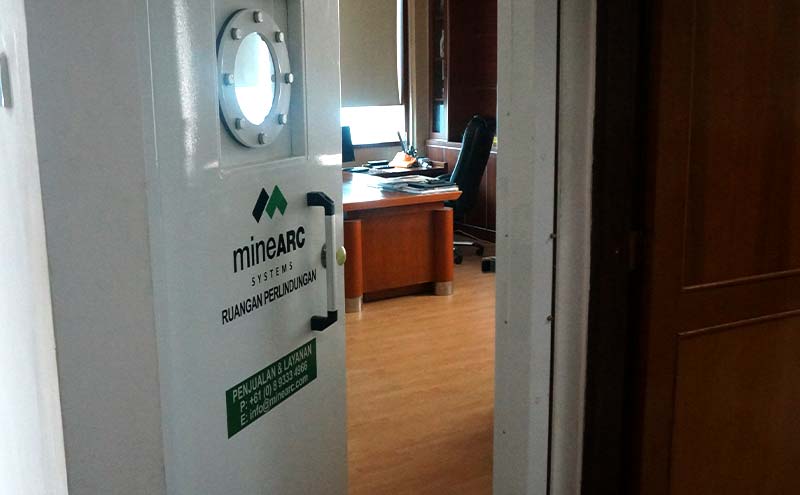Shelter-in-Place (SIP) is a common term used in community and commercial emergency response actions plans. It refers to the process of taking refuge by staying indoors and sealing your environment.
SIPs can be deployed across a multitude of emergencies ranging from wildfire smoke, chemical release, or dangerous personnel in the area.
Government websites often have a shelter-in-place action plan for residential areas; most of which will prompt you to seal the surrounding environment and stay indoors until notified. This course of action can be practical for residential spaces, however, for protection within a chemical or manufacturing facility, the risk is likely to exceed this level of protection.
Sealing a Shelter-in-Place
The effectiveness of a SIP depends on the ability to seal the location from the external environment to prevent hazards from entering.
For airborne toxins and contaminants, the ability to successfully close off an area is impacted by the air exchange rate from:
- Infiltration: air leakage from cracks and broken seals
- Natural ventilation: open plan, grills, louvres, transom windows
- Mechanical ventilation: exhaust fans, air conditioners
The higher the exchange of air inside the shelter, the less protection it provides. To determine if a SIP can provide a suitably safe environment, you will need to calculate the air changes per hour (ACH).
Types of Shelter-in-Place
The Chemical Stockpile Emergency Protection Program (CSEPP), has identified four stages of Shelter-in-Place, each with differing levels of security and preparation time.
Taking refuge in an existing building and closing all doors, windows, and vents as well as turning off all air conditioning, heating, and ventilation systems. Going to an interior room, with minimal doors and windows, will improve the level of protection, if possible.
In addition to normal sheltering, further steps are taken to help seal the environment, including applying plastic sheeting and tape to windows, doors, vents, and electrical outlets.
For this form of sheltering, permanent barriers such as weather strips and storm windows have been built into the structure to reduce infiltration. Because the structure has integrated protection measures, it is faster to implement than expedient sheltering.
Pressurised SIP requires a designated sealed room and positive pressure, created with large fans. These shelters are expensive to set up and use and are not typically used for the general public.
With the right equipment and expertise, a shelter-in-place can be transformed into a zero vulnerability safe haven; highly recommended for industrial petrochemical facilities.
Implementing Emergency SIP
For residential areas, normal and expedient are the most common forms of sheltering. These types of SIP are fast and straightforward to implement.
Medium to lower level shelters reduce the infiltration of airborne contaminants; however, will not prevent the hazard from entering. Reduce infiltration shelters provide limited protection; dependant on duration, concentration, and proximity to the release. As the chemical plume travels and expands, it becomes more diluted. Shelters in closer proximity to the release will be exposed sooner, and to higher concentrations, compared to those farther downwind.
Applying expedient sealing techniques, such as duct taping door seals, will limit airborne hazards to a certain extent. However, the time taken to implement such measures, varying from 20 mins – 1 hour, impacts the level of air quality within the safe room. For large releases under moderate atmospheric conditions, “expedient sheltering” resulted in higher indoor air concentrations than “enhanced sheltering” due to the longer implementation time. Rogers et al. (1990)
How To Shelter-in-Place: A CSEPP Basic Guide
The CSEPP offers some basic steps for Shelter-in-Place:
SIP is Good
SIP is Good
SIP is Better
SIP is Better
SIP is Best
SIP is Best
Entering and Exiting a Shelter-in-Place
Timing of entering and exiting a SIP is critical to its ability to provide adequate protection. Entering a SIP too late, and the internal environment may already be contaminated. Leaving the shelter too late increases an occupants exposure to additional hazards. Because a SIP is not airtight, exposure risk continues for people within a reduce infiltration shelter, due to cumulative contact.
Once safe to exit, a SIP will need to be ventilated and vacated once the plume has passed.
Rogers, G.O., Watson, A.P., Sorensen, J.H., Sharp, R.D. and Carnes, S.A., 1990. “Evaluating Protective Actions for Chemical Agent Emergencies”, ORNL-6615, Oak Ridge National Laboratory, Oak Ridge, TN.







